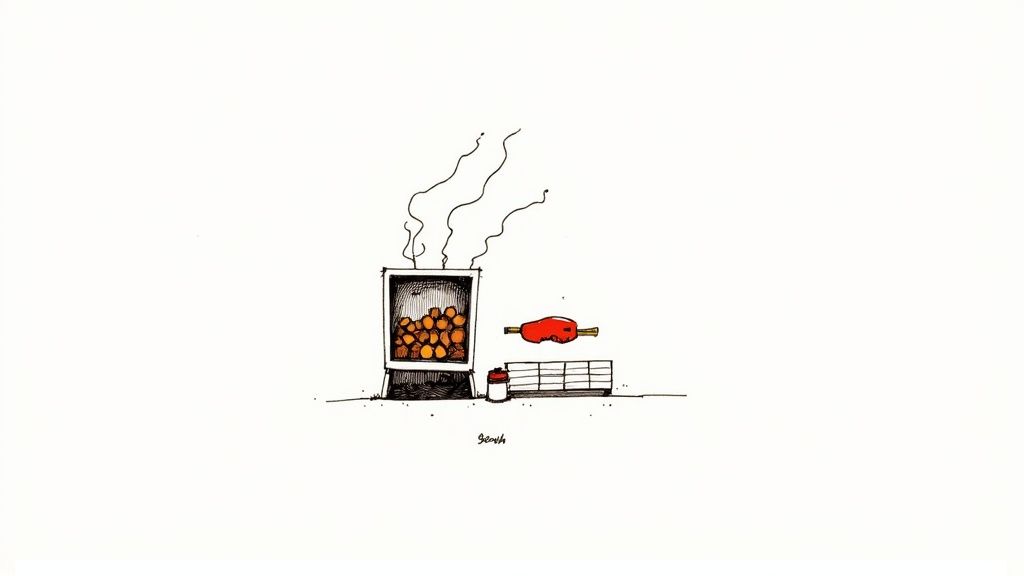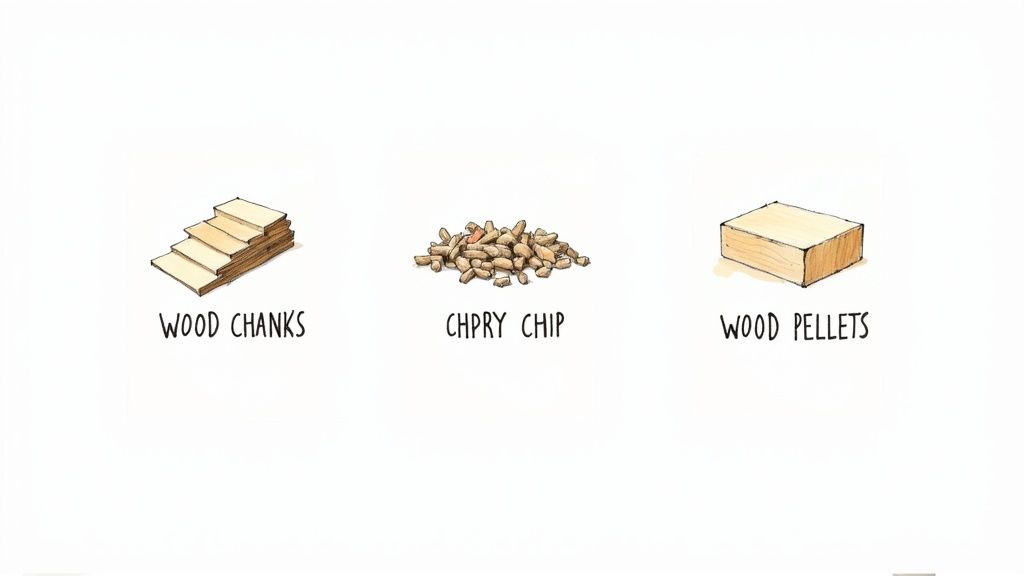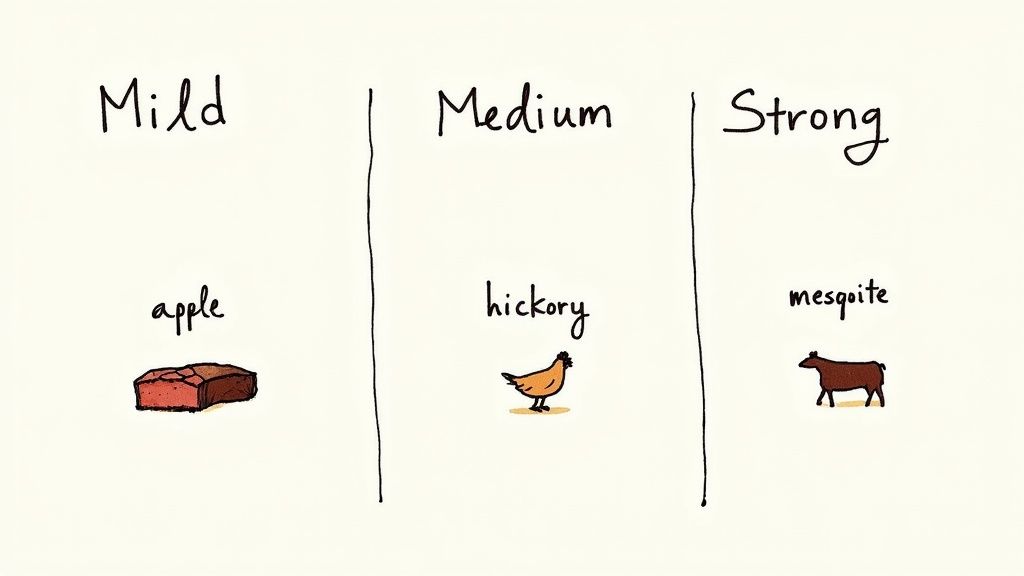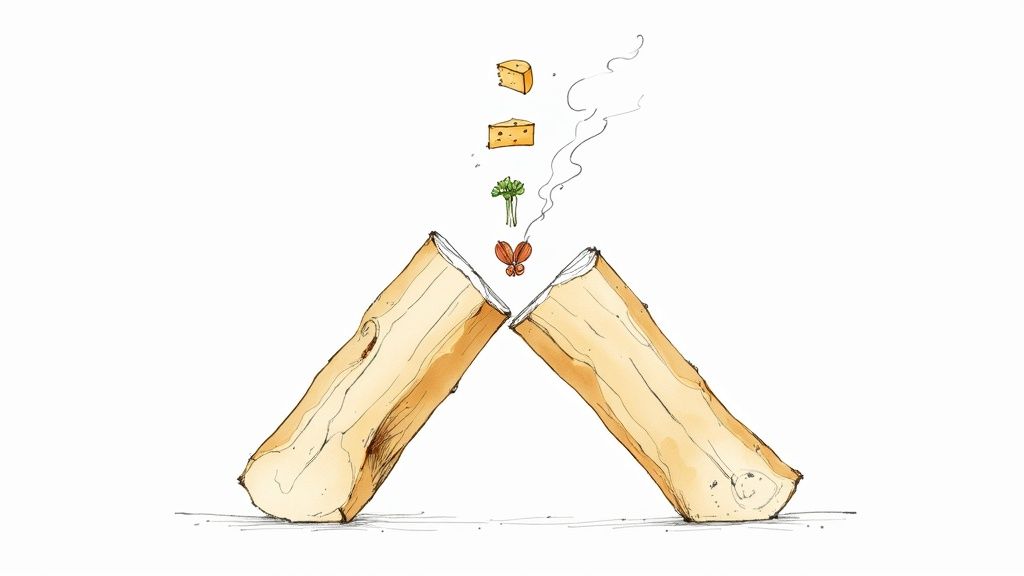Your Guide to Smoked Wood for BBQ Perfection
If you want to turn good BBQ into something truly special, you need to master smoke. It’s the single most important ingredient after the meat itself, defining the character, depth, and soul of everything you cook.
Forget thinking of wood as just fuel. It's the ultimate seasoning, and we're here to show you how to use it.
Your Journey Into Flavourful Smoking Starts Here

Welcome to the definitive guide on smoking woods. This is where we stop just cooking with fire and start painting with smoke, creating layers of authentic flavour that you just can't get any other way. The right wood is every bit as crucial as a prime cut of meat or a perfectly balanced rub.
Think of this guide as your roadmap to becoming the flavour king of your own back garden. We’ll break down everything you need to know into simple, actionable steps.
What You Will Learn
Here’s a look at what’s ahead:
- The Science of Smoke: Get your head around how different woods release unique flavour compounds.
- A Practical Pairing Guide: Discover which woods are best friends with beef, pork, chicken, fish, and even veg.
- Wood Formats Explained: Learn the difference between chunks, chips, and pellets, and exactly when to use each one.
- Mastering Your Fire: Get the proper steps for achieving that perfect, clean "thin blue smoke."
Great BBQ is a symphony. It's the rich taste of brisket, the bold kick of a proper seasoning like our Revolution Beef Rub, and the aromatic soul of real wood smoke. When you get all those elements working together, that's when the magic happens.
The Rise of Gourmet Grilling
The art of smoking food is exploding across the UK. It’s moved from a niche hobby to a full-blown culinary passion, fuelled by our desire for more authentic, flavour-packed food at home. As garden get-togethers become the new going out, the demand for quality BBQ gear and ingredients has gone through the roof.
It helps that more of us have the space to get serious about it. According to the Office for National Statistics, by 2022, 81% of London households had access to private outdoor space. That’s a lot of potential for grills and smokers.
Mastering smoked wood for BBQ isn’t just for seasoned pitmasters anymore; it’s a core skill for any modern cook looking to up their game. This guide will give you the solid foundation you need to start your adventure with confidence.
Choosing Your Fuel: Chunks, Chips, or Pellets

When you first dive into the world of smoking, staring at a wall of wood chunks, chips, and pellets can feel a bit much. Don't sweat it. The choice is actually pretty simple and comes down to three things: what you're cooking on, how long you're cooking for, and how much smoke flavour you want.
Think of them as different tools in your flavour toolbox. Picking the right one is the first real step to getting control over your cook and nailing those delicious, smoky results every time. Let’s break down the big three so you can grab the right bag with confidence.
Wood Chips: The Quick Flavour Boost
Wood chips are basically little splinters of wood, and their main job is to give you a quick, intense blast of smoke. Because they're so small, they catch light and burn out fast, making them perfect for shorter cooks.
They're the sprinters of the smoking world. You'll want to reach for chips when you're:
- Using a Gas or Electric Grill: Pop them in a smoker box or a foil pouch with a few holes poked in it, then place it over the heat to get the smoke rolling.
- Cooking Fast Foods: They’re brilliant for adding a kiss of smoke to things like fish, chicken breasts, sausages, or veggies that are only on the grill for 30-60 minutes.
The downside? If you're tackling a brisket or a pork butt, you'll be endlessly topping up the chips to keep the smoke going. That constant meddling can mess with your grill's temperature. That's when you need their bigger, beefier cousin.
Wood Chunks: The Low-and-Slow Workhorse
Wood chunks are fist-sized blocks of wood, and they are the undisputed champions of proper low-and-slow barbecue. Their size and density mean they'll smoulder away for hours, giving you a steady, consistent stream of clean smoke without you having to do a thing.
Chunks are your go-to for any authentic barbecue cook that lasts for hours. They deliver that sustained, gentle smoke you need to break down tough cuts and build that legendary bark and smoke ring.
This makes them the perfect fuel for dedicated smokers:
- Charcoal Grills: Just toss a few chunks right on top of your hot coals.
- Offset Smokers: In an offset, chunks are your primary fuel source in the firebox.
- Kettle Grills: They work perfectly with methods like the "snake" or "minion" for a long, stable burn.
Because they smoulder instead of flaring up, chunks produce that "thin blue smoke" that all the pros chase—it's the key to a clean, rich flavour without any bitterness.
Wood Pellets: The Modern Standard for Consistency
Finally, we've got wood pellets. These little guys are made from compressed sawdust, and they offer incredible consistency and dead-simple ease of use. They are the required fuel for modern pellet grills, which automatically feed them into a fire pot to hold a precise temperature. Honestly, it takes all the guesswork out of temperature control.
Pellets provide a clean, reliable smoke and are ridiculously efficient. While they were born for pellet grills, people are finding new ways to use them all the time. If you want to dive deeper, our guide to BBQ with wood pellets has everything you need to know.
We believe great flavour should be simple, which is why we developed our own range of high-quality Smokey Rebel Wood Pellets. They're made with 100% pure wood and no added crap or fillers, giving you authentic flavour you can rely on, cook after cook.
A Comprehensive Wood and Meat Pairing Guide

Right, let’s get to the good stuff: matching the right wood to the right meat. This is where the real magic happens. Think of it like being a composer. The wood, the meat, and your rub are all instruments. Get them playing in harmony, and you create something truly special.
The secret is understanding the personality of each wood. Some are subtle and whisper their flavour, while others are bold and shout it from the rooftops. We can break them down into three main camps: mild, medium, and strong. Nail this, and you'll turn a simple cookout into a seriously memorable feast.
Mild Woods: Sweet and Subtle
Mild woods are your best friend when you’re starting out or cooking delicate foods. They add a light, often fruity or sweet kiss of smoke that complements flavours without barging in and taking over. These are your go-to choices for things like poultry, fish, and pork.
- Alder: This is the classic wood for smoking salmon, and for good reason. It has a light, sweet flavour that’s incredibly delicate, working wonders with most fish and poultry.
- Apple: Probably one of the most popular fruitwoods out there. Apple smoke is mild, sweet, and distinctly fruity. It’s fantastic with pork and poultry, slowly layering the meat with a gentle, aromatic smoke.
- Cherry: A bit sweeter than apple with a lovely fruity tang. Cherry is famous for giving poultry a beautiful deep-red skin. It pairs brilliantly with chicken, turkey, and ham.
Pro Tip: How to Pair Cherry Wood and Rubs in 2 Minutes
- Pat your chicken thighs or wings dry with a paper towel.
- Drizzle with a little olive oil and toss to coat.
- Generously season with our Cherry Force BBQ Rub, ensuring an even layer.
- Set up your smoker with cherry wood chunks and cook until perfect. The fruity notes in the rub and the smoke combine for an incredible layer of flavour.
Medium Woods: The Versatile All-Rounders
Medium woods bring a more confident smoke flavour to the party without being overwhelming. These are the real workhorses of the barbecue world, versatile enough for just about any meat and perfect for building that classic smoky taste we all chase.
- Oak: When in doubt, go with oak. It’s easily the most versatile smoking wood, giving you a solid medium smoke that’s stronger than apple but not as intense as hickory. It burns clean and is brilliant for beef (especially brisket), lamb, and sausages.
- Hickory: This is that classic, all-American BBQ flavour. Hickory smoke is punchy, bacony, and a little sweet. It’s the traditional choice for pork ribs, shoulders, and bacon, but a word of warning—go too heavy with hickory, and your meat can turn bitter.
A great way to use hickory is to pair its bold smoke with a rub that can hold its own. For pork ribs or a pulled pork shoulder, the deep, savoury notes in our Hickory Hog Pork Rub stand up to the smoke perfectly, creating that iconic barbecue taste. It’s a combination that always wins.
Strong Woods: Bold and Intense
Strong woods are for when you want a powerful, no-messing-about smoke flavour. These are best saved for big, robust cuts of meat—especially beef—that can handle the intensity. You'll want to use them sparingly, as their potent smoke can easily dominate the whole dish.
- Mesquite: The undisputed king of strong smoke. Mesquite has a very earthy, intense flavour that’s unmistakable. It also burns hot and fast, which makes it ideal for grilling steaks or other quick-cooking cuts. If you’re using it for a low-and-slow smoke, it's best to mix it with a milder wood like oak to tame it a bit.
Getting to grips with strong woods is a real milestone on your journey to becoming a true pitmaster. For anyone taking on the ultimate challenge of a beef brisket, understanding what oak and mesquite bring to the table is vital. For a full walkthrough, check out our guide on how to smoke a brisket.
Smoking Wood and Meat Pairing Chart
To make things even easier, here’s a quick reference chart. Think of this as your cheat sheet for matching woods, meats, and rubs to get the best results every time you fire up the smoker.
| Wood Type | Flavour Profile | Best Paired With | Recommended Smokey Rebel Rub |
|---|---|---|---|
| Alder | Delicate, sweet, light | Salmon, fish, poultry | SPG Base Blend or a light herb rub |
| Apple | Mild, sweet, fruity | Pork, chicken, turkey | Hickory Hog Pork Rub |
| Cherry | Mild, sweet, slightly fruity | Chicken, ham, pork, turkey | Cherry Force BBQ Rub |
| Oak | Medium, classic smoky | Beef brisket, lamb, sausages, any red meat | Revolution Beef Rub |
| Hickory | Strong, bacon-like, sweet | Pork ribs, pulled pork, bacon | Hickory Hog Pork Rub |
| Mesquite | Very strong, earthy, intense | Steak, beef, game meats (use sparingly) | SPG Base Blend or Revolution Beef Rub |
This chart is a great starting point, but don't be afraid to experiment. The best part of barbecue is finding the combinations that you love the most. Happy smoking.
Mastering the Art of Thin Blue Smoke
Knowing which wood to use is one thing. Knowing how to burn it for the best possible flavour is another. This is where the real pitmasters separate themselves from the crowd.
The holy grail is what’s known as “thin blue smoke”—a nearly invisible wisp that packs incredible flavour without any of the harsh, bitter notes you get from a badly managed fire. Getting it right isn't about complex theories; it's about a few simple, repeatable steps you can use on any grill or smoker to get pro-level results, every single time.
To Soak or Not to Soak Your Wood
Let's put this old debate to bed for good. For years, the common wisdom was to soak your wood chips or chunks in water before adding them to the coals, thinking it would make them smoulder longer. Science, however, tells a very different story.
Soaking wood doesn't create smoke; it creates steam. Before the wood can actually combust and produce that gorgeous, flavourful smoke, all that water has to boil off. This process actively cools down your fire, leading to dirty, acrid smoke and making it a nightmare to control your temperature. The smouldering you see is just the wood drying out, not smoking properly.
The Verdict: Don't soak your wood. Dry wood ignites cleanly and burns efficiently, producing the thin blue smoke you're after. You want the wood to smoulder from a controlled heat and lack of oxygen, not because it’s waterlogged.
Practical Setups for Perfect Smoke
How you add wood to your fire depends entirely on your setup. Whether you're using a classic kettle grill, a dedicated smoker, or even a gas barbecue, the principles of clean combustion are exactly the same.
For Charcoal Grills and Smokers (The Snake Method)
The snake method is a brilliant technique for getting a long, stable burn in a kettle grill. It’s perfect for low-and-slow cooks like pork shoulder or ribs.
- Arrange the Coals: Make a C-shaped "snake" of unlit charcoal briquettes, stacking them two-by-two around the inner edge of your grill.
- Add the Wood: Place 3-4 wood chunks evenly along the top of the first half of the snake. Spacing them out gives you consistent smoke throughout the cook.
- Light the Fuse: Light just 8-10 briquettes in a chimney starter. Once they’re fully ashed over, pour them right at the start of the snake.
- Control the Airflow: Put your meat on the opposite side from the lit coals. Pop the lid on with the top vent positioned over the meat, and then adjust your bottom and top vents until you’re holding a steady temperature (usually around 110-135°C or 225-275°F). The snake will burn slowly for hours, igniting the wood chunks as it goes.
This hands-off method delivers steady heat and clean smoke for up to 10-12 hours—an absolute game-changer for those long cooks.
For Gas Grills (Using a Smoker Box)
You can absolutely get great smoke flavour from a gas grill. You just need the right tool for the job. A simple smoker box or even a homemade foil pouch is all it takes.
- Prepare the Wood: Fill your smoker box with dry wood chips. If you’re making your own, use heavy-duty foil and poke a few small holes in the top to let the smoke escape.
- Position for Heat: Place the box or pouch directly over one of your lit burners, ideally right under the cooking grate. You want it as close to the heat as possible.
- Preheat and Smoke: Crank that burner on high and close the lid. Wait for the chips to start smoking, which might take 10-15 minutes. Once you see a steady stream of smoke, turn that burner down and adjust the others to hit your target cooking temperature.
- Cook with Indirect Heat: Place your food on the opposite side of the grill from the smoker box. This lets it cook low and slow with indirect heat while bathing in all that delicious smoke.
Just remember to have a second box or pouch ready to swap in, as chips burn out a lot faster than chunks.
Sourcing and Storing Your Smoking Wood
Great BBQ doesn't start at the smoker—it starts with the wood. Think of it like cooking with a good bottle of wine; what you put in is what you get out. Using top-quality, properly seasoned wood is the only way to get that clean, aromatic smoke that makes great food unforgettable.
When you're picking out wood, you're looking for quality. The pieces should feel solid and dry in your hand, not damp or spongy. Give them a quick once-over for any signs of mould, mildew, or insect holes. That stuff will just create nasty, off-flavours in your cook. A good bit of smoking wood should just smell clean, with a faint, pleasant hint of the tree it came from.
What to Look For and What to Avoid
Here’s your quick checklist for spotting the good stuff:
- Properly Seasoned: This is non-negotiable. The wood needs to be dried to a moisture content of around 20%. If it's too "green" (freshly cut), you'll get a thick, bitter smoke full of creosote that will completely ruin your food.
- No Contaminants: Never, ever use wood that has been painted, treated, or stained. Only ever use wood that's specifically meant for cooking.
- Bark On or Off? For most woods, a bit of bark is totally fine. But for some, like hickory, the bark can add a slightly bitter edge, so some pitmasters make a point of knocking it off.
More importantly, there are some woods you must never let anywhere near your smoker. Softwoods like pine, fir, cedar, and spruce are loaded with resin. Burn them, and you'll get a foul, sooty smoke that'll taint your meat and gunk up your cooker. The same goes for any pallet wood or treated timber, which can release seriously dangerous chemicals.
Storing Your Wood for Maximum Flavour
Once you've got your hands on good quality wood, you need to store it properly to protect your investment. The mission is simple: keep it dry and give it plenty of air circulation to stop any mould from setting in.
For wood chunks and splits, an outdoor wood rack with a cover is perfect. The key is to stack it off the ground so moisture can't creep in from below. If you're using chips or pellets, a sealed, weatherproof container in the garage or shed is all you need. This keeps them perfectly dry and ready to go.
Keeping your fuel in prime condition, like our premium Smokey Rebel Wood Pellets, is the secret to getting consistent, clean smoke every single time you fire up the grill.
This focus on quality is becoming a bigger deal. Here in the UK, people are getting more clued up about where their fuel comes from, with a huge swing towards sustainable and eco-friendly options. You can discover more about this trend in the UK BBQ charcoal market and see how conscious choices are shaping the future of British BBQ.
Advanced Smoking Techniques and Flavour Blends

Once you’ve nailed the basics of pairing a single wood with your meat, it’s time to start thinking like a true flavour pioneer. Advanced smoking isn't about complicated gear; it's about getting creative and building layers of flavour that are uniquely yours.
This is where you move from following the recipe to writing your own.
The first step? Start blending your woods. Think of it like a chef mixing spices. By combining different types of wood, you can create a custom smoke profile that’s far more complex and interesting than using a single type on its own.
Creating Your Own Wood Blends
Blending woods lets you balance their characteristics, creating a proper symphony of smoke. You can pair a strong, punchy wood with a mild one to get the best of both worlds.
Here are a few classic combinations to get you started:
- Hickory & Apple: This is a fantastic blend for pork shoulder. The strong, bacon-like flavour of hickory is mellowed by the gentle sweetness of apple, creating a rich yet perfectly balanced taste.
- Oak & Cherry: Brilliant for beef ribs or brisket. Oak provides that solid, classic smoke foundation, while cherry adds a touch of sweetness and a beautiful dark mahogany colour to the bark.
- Mesquite & Pecan: Use this one carefully. A 70/30 split of pecan to mesquite can tame the intense earthiness of the mesquite, making it spot-on for a thick steak or even duck.
Beyond the basics, looking into different traditions, like the Japanese wood burning technique, can offer fascinating perspectives on how wood interacts with fire to release its character.
Smoking More Than Just Meat
True mastery of smoking means applying your skills to anything you can imagine. The gentle heat and aromatic smoke can transform everyday ingredients into something truly special.
Why not try:
- Smoked Vegetables: Asparagus, bell peppers, and corn on the cob are incredible when smoked. Toss them with our versatile SPG Base Blend before smoking for a simple, savoury side dish.
- Smoked Nuts: Almonds, pecans, and cashews are perfect for this. A light dusting of the fiery Spitfire Spice Blend before a 45-minute smoke with apple wood creates an addictive snack.
- Smoked Cheese: A block of cold-smoked cheddar or Gouda is a game-changer for any cheese board. Seriously.
This is your chance to experiment without limits. The best way to match your new smoking creations with the perfect seasoning is to head over to our Build Your Own Bundle page. Pick out a few rubs that intrigue you and start discovering your next signature flavour combination.
Your Smoking Wood Questions Answered
Got questions? Good. It means you’re on the right track. Let's tackle some of the most common queries we hear about smoking wood to help you get it right from the get-go.
How Much Smoking Wood Do I Actually Need?
This really boils down to your smoker, how long you're cooking for, and how much smoky flavour you’re after. The golden rule? You can always add more, but you can't take it away. Over-smoking is a one-way ticket to a bitter, acrid dinner.
Here’s a solid starting point:
- Charcoal Smokers: For a long, slow cook like a pork shoulder, chuck in 3-4 fist-sized chunks. That’ll give you a nice, steady stream of smoke for hours on end.
- Gas Grills: A couple of handfuls of wood chips in a smoker box is all you need for shorter cooks. This should keep the smoke rolling for about 45-60 minutes.
What you’re aiming for is a thin, almost invisible blue smoke, not great big puffy white clouds. That’s the good stuff.
Can I Just Use Wood From My Garden?
Tread very, very carefully here. If you can be 100% certain you have an untreated, well-seasoned hardwood like apple, cherry, or oak on your property, then maybe.
But here’s the crucial bit: never, ever use softwoods like pine, fir, or cedar. The resin in these woods creates a nasty, sooty smoke that tastes disgusting and can make you ill. Same goes for treated lumber, painted wood, or bits of old pallets. Don't do it.
To be safe, stick with wood that’s been specifically prepared for smoking.
What’s the Best All-Rounder Wood for a Beginner?
Easy. Oak.
Oak is the friendly giant of the smoking world. It’s got a classic, medium-strength smoke flavour—not as punchy as mesquite, but with more character than super-mild fruitwoods.
Its biggest advantage is its versatility. Oak works with pretty much anything you throw at it, but it’s especially brilliant with beef. It’s a forgiving and reliable choice while you’re still getting the hang of controlling your fire and smoke.
Ready to put all this into practice and cook up something incredible? Grab the authentic, no-crap seasonings you need from Smokey Rebel and find the perfect partner for your next cook. Our Bar-B-Que Heroes Bundle is a great place to start.
Join our Mailing List
Sign up and get Smokey Rebel Recipes + weekly recipes straight to your inbox!
Recent articles
The Ultimate Pellet BBQ Grill Guide
Discover everything you need to know about a pellet BBQ grill. Learn how they work, their key benefits, and how...
Read moreYour Guide to Smoked Wood for BBQ Perfection
Discover the best smoked wood for BBQ in our guide. Learn to pair wood flavours with meats and master the...
Read moreA Modern Guide to BBQ with Wood Pellets
Master the art of BBQ with wood pellets. This guide covers pellet selection, temperature control, and pro techniques for perfect,...
Read more


